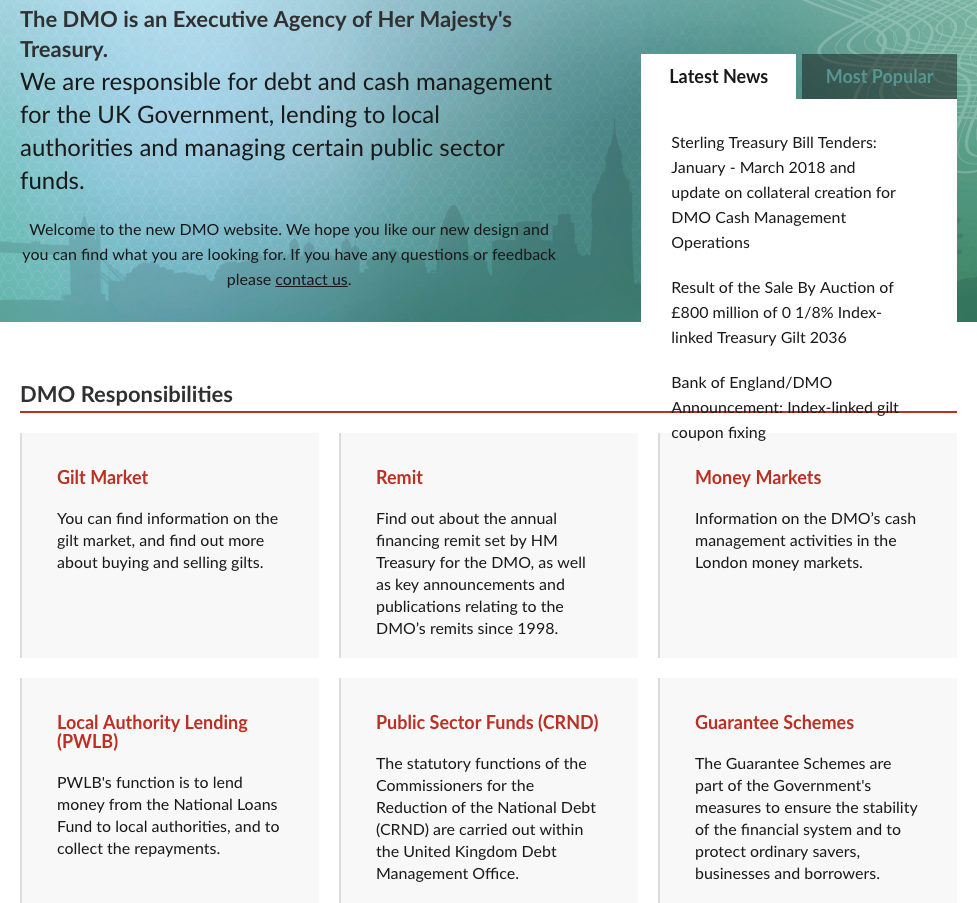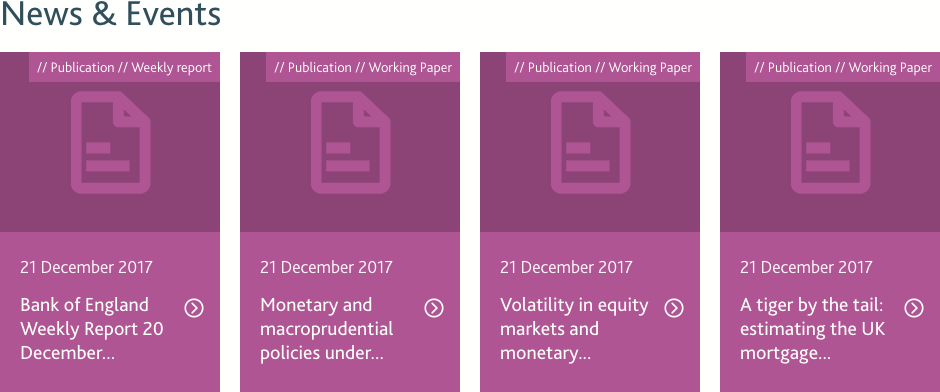| Main index | Financial Markets index | About author |
Julian D. A. Wiseman
Abstract: In December 2017 both the UK DMO and the BoE rotted most incoming links. The BoE did it worse. Both could and should have websites that are more robust, with links that are effectively permanent.
Publication history: only at www.jdawiseman.com/papers/finmkts/20171231_Rotting_links_DMO_BoE.html. Usual disclaimer and copyright terms apply.
Contents: • Introduction; • The DMO; • The BoE; • Recommendations (Keep history; File structure = database; Data and link density); • Afterwords (From the DMO, Tuesday 2nd January 2018).
In December 2017 both the Bank of England and the UK Debt Management Office rotted most incoming links. That is, pages were moved such that external deeplinks were broken. Perhaps their webmasters would describe this as a re-arrangement of the website, necessitating changes of URLs. Perhaps.
Each has done this before: the DMO in September 2006 (before, after), and the BoE on 1st March 2012 (before, after).
The Bank of England, prior to its 2012 link-rotting, had been a model internet citizen: links from the start of its website in 1996 still worked. But somebody wanted to install aspx, and didn’t care two hoots about incoming links.
Back to 2017: both the DMO’s and BoE’s link-rottings are needlessly bad, but the BoE’s is considerably worse.
The DMO’s website was clunky. Pages such as “What’s New” would work if clicked from the main page, but not if that link were in a bookmark. Because one could not jump straight to the relevant page, a modernisation had a proper purpose. But it broke almost all incoming links.
The link www.dmo.gov.uk/publications/?offset=0&itemsPerPage=99999&startMonth=1&startYear=1990 shows all publications, sorted by date. Helpfully, nearly all file names were not changed, which was an act of mercy for me, as it was enough to allow mostly-automated substitution of old links.
Further, the DMO discarded very little of its history. Almost all files on the old website are present on the new. The few exceptions known to this author are as follows (the text is that of the pre-Dec2017 link, the link is to web.archive.org).
Out of several thousand documents, that’s not bad. (Doubtless there are others, but these are the missing pages to which there were links on my pages of conventionals and non-conventionals.)
The new website itself is mediumly good. In for a penny, in for a pound: I shall venture a few criticisms.
It has on the front page a small display, “Latest News”. For market professionals, often as not, this is the most important thing. But—inevitably there was going to be a ‘but’—not all is perfect.
There are only three ‘Latest’ items.
As of 31st December 2017 it doesn’t show the latest news. It is missing two pages about the Standing Repo Facility: its new terms and conditions; and a screen announcement.
The title “Latest News” does not link to a longer list of recent news.
The front page has a space-hogging set of six links, pictured. They’re huge, for just one link each.

And they are badly written, or at least, not written for the web. Users of the web quickly scan pages for the correct link. Hence the first three or four words of each link-paragraph should be high-information determinants; never fluff. E.g.:
Spreading things out, so that there is lots of elegant white space, always looks cool on the website designer’s 27″ screen. It’s easy to imagine the pitch: ‘elegant’, ‘dramatic’, ‘dignified’. Now switch to a real-world screen, whatever the size it being too small, with several open windows. This website isn’t meant to be a BAFTA competitor—the missing word is ‘efficient’. Screen space is always in short supply: be efficient. Be tight.
My bookmarked home page for the new DMO website is www.dmo.gov.uk/publications/?offset=0&itemsPerPage=999&startMonth=9&startYear=2017, and to reduce download time I will occasionally update its start year and month. Again, there is a spacing problem, it taking 96 pixels per line. Be tight: three or four lines could comfortably fit where currently there is one.
And a link like this should be on the front page.
Until 2012 the Bank of England was a model internet citizen. But for the second time the BoE has rotted many incoming links.
The Bank of England was founded in 1694, because Charles II had been a multiple defaulter, and improved institutions would improve credibility. And did: hurray! The Bank of England should embrace its history, not discard it.
Every announcement that has ever been on the BoE’s website should still be there. Every, from the beginning. As should every Governor’s speech since 1694; and anything else that might possibly be of interest to any scholar. The Bank should be, perhaps gradually, decanting its entire archive into the website. Instead there is a history purge.
For example, there was a link on my website to www.bankofengland.co.uk/publications/Pages/news/2013/016.aspx (copy on web.archive.org). Gone. Not just gone from its original URL, but gone gone. No longer anywhere on the BoE’s website (BoE search, as of 31st December 2017, yields nothing). I accept that the redemption amount of 2½% Index-linked Treasury Stock 2013, being £276.6768 per £100 nominal, is only a very small part of the financial history of the UK. But why purge history? Really, why?
Count how many clicks it takes to get to the most recent MPC minutes (if published in the last few days, count how many clicks to the previous). Why in search, does specifying a type of publication and a date cause the type-specification to disappear? So that I can’t change it? It’s awful.
Next, more space-hogging, at an even lower information density than that of the DMO. Behold the following rectangles:

Pink is good: the Bank of England’s porters wear pink waistcoats, and an echo of that is good.
As with the DMO, one link per huge space—indeed, huger than for the DMO. For the Bank of England, the kindergarten style is wrong.
At the top of each is some link-like text, part of the graphic so not copy-pasteable. I’m not asking why; please don’t tell.
Below each pseudo-link is a large icon with rounded corners. All identical, so information-free. I was reminded of the example at the bottom of page 95 in Edward Tufte’s The Visual Display of Quantitative Information.
Next, a date. But these four are the most recently published papers, so their dates will be close or identical—which doesn’t stop them occupying much vertical space.
And finally the first few words of the title.
The space used by these four rectangles could easily hold the twenty most recent publications, with their full titles. And should.
What should be done?
The UK DMO and the BoE are public institutions, whose pronouncements are matters of record. For aeons these will interest historians, macro-economists, and micro-economists. Do not attempt to conceal this history. All announcements and publications that have ever been online should remain so. And to them should be added more from the pre-internet age.
Database software enforces its own structure on everything. The BoE’s switch to Microsoft’s aspx in 2012 forced all links to look like that: mass link rot. But know that today’s database will not necessarily sit happily with tomorrow’s hardware | operating system | database licensing cost | webmaster’s preferences | seemingly random orders from a boss. It just won’t.
Understand that the DMO and the BoE are not Amazon, nor British Airways, nor Sainsbury’s. Large companies selling to consumers want to change their prices many times a day. They want to experiment with presentations and offers, showing different things to different customers to discover what works at this moment. Millions of differently constructed pages might be shown each day, the software recording the pages shown to whom and when, and what action the customer took. All of which requires a powerful database.
That is not the DMO, nor the BoE. Entities producing fixed documents of record, which will be of interest in a century, need to be more robust by being more primitive.
There is no need for database software: the file structure can do that. Files should be static, and each file’s URL should be its directory path (prefixed by the domain name). I.e., the file structure is the ‘database’, and the ‘database’ is the file structure. That allows links to resemble www.bankofengland.co.uk/2017/12/MPC/20171214_minutes.pdf, and ….html. Each directory should have a simple index.html page, pointing to each file in that directory and to the index.html page in each sub-directory (these pages could be made by a script, but once generated would then be static files).
This simplicity has multiple benefits.
The file structure does the work. If the database fails, the website doesn’t. Indeed, there might not be a database.
Trivally easy to maintain, because there is no license-money-demanding fragile database software.
New webmaster ⇏ link rot. New toys ⇏ link rot. Increased database licensing fees ⇏ link rot.
Links can last for ages. ‘Forever’ is a big word, so instead let’s say that links can be stable for unbounded ages. My website, jdawiseman.com, online since March 1999, uses the file structure as the link structure, and with very little maintenance and no database fees has managed never to rot a link.
There will be some pages, such as those providing economic time series, for which a database might be better. If there are only a few possible outputs (such as static details of all gilts issued since 1945), then these can be fixed pre-generated files in which a few tens of kilobytes contain all the data, tab-separated. But the BoE has very many economic time series, with too many updates for this, so the whole website cannot be robust to database misery. But much of it can, even most. Indeed, much of it should, even most.
Webmasters should know the childishness of the target audience. If that audience comprises academics and market professionals, then favour data density and link density over anything that is content-free. If something looks like vacuous fluff, if your audience might perceive it to be obstructive content-free decoration, delete it. If you can’t bring yourself to delete it, shrink it, and then delete it. Yes yes, branding—sigh!—keep it small, so small that it is unobstructive even on a very small screen. A company that is all branding is all branding and that can’t be dodged, but the public sector should prioritise function over adornment.
Rephrased, decide whether you hate your target audience, and act fully on that decision.
— Julian D. A. Wiseman
London, 31st December 2017
www.jdawiseman.com
On Tuesday 2nd January, the first business day after this essay was published (impressive responsiveness), the DMO replied. The following gathers extracts from the reply and subsequent correspondence.
I have had a looked through your ‘rotten links’ page and would like thank you for pointing out that some of the links have indeed been lost. This was not the plan when migrating to the new website and so I have asked for the documents to be added in ASAP.
I would like to point out however, that of the 7 documents listed within ‘The Debt Management Office’ section, 4 of the documents can actually be found on the website. For ease, I provide the new links … [1, 2, 3, 4]
The web team have confirmed that the other documents have been published and the links are below. [ 6, 7, 8 ]
Thank you for adding the missing documents, and so quickly.
Comment on making links more robust by being database-free would be welcome; as would comment on the user-interface matters.
| Main index | Top | About author |